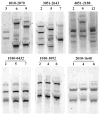Hepatitis C virus quasispecies in HIV-infected women: role of injecting drug use and highly active antiretroviral therapy (HAART)
- PMID: 17659581
- PMCID: PMC3508063
- DOI: 10.1002/hep.21715
Hepatitis C virus quasispecies in HIV-infected women: role of injecting drug use and highly active antiretroviral therapy (HAART)
Abstract
Despite the high frequency of HCV and HIV coinfection, little is known about HCV quasispecies in HIV-positive patients. The current analysis included 236 HIV+/anti-HCV+ women enrolled in the Women's Interagency HIV Study (WIHS). Hypervariable region 1 of the second envelope gene was analyzed by single-strand conformation polymorphism (SSCP). The relationship between the HCV quasispecies and clinical and demographic features were analyzed in multivariate models. Age over 40 years and high HCV RNA load were the only factors significantly associated with quasispecies complexity, assessed as the number of SSCP bands. High HIV and HCV plasma loads were associated with quasispecies stability over time, as reflected by stable SSCP band patterns. However, women who were actively injecting drugs were 3 times more likely to experience quasispecies changes than their noninjecting counterparts. No affect on HCV quasispecies dynamics was noted in relation to CD4 count or highly active antiretroviral therapy (HAART).
Conclusion: among HIV/HCV coinfected patients, HCV quasispecies complexity and dynamics correlate more closely with HIV and HCV plasma loads than with CD4+ cell counts. Active drug use is associated with quasispecies changes probably due to repeated superinfections with new HCV strains. This needs to be considered when planning treatment and prevention strategies for HCV in coinfected individuals.
Conflict of interest statement
Potential conflict of interest: Nothing to report.
Figures


Similar articles
-
Evolution of HVR-1 quasispecies after 1-year treatment in HIV/HCV-coinfected patients according to the pattern of response to highly active antiretroviral therapy.Antivir Ther. 2006;11(1):87-94. Antivir Ther. 2006. PMID: 16518964
-
Impact of highly active antiretroviral therapy and immunologic status on hepatitis C virus quasispecies diversity in human immunodeficiency virus/hepatitis C virus-coinfected patients.J Virol. 2003 Feb;77(3):1940-50. doi: 10.1128/jvi.77.3.1940-1950.2003. J Virol. 2003. PMID: 12525628 Free PMC article.
-
HIV infection and antiretroviral therapy: effect on hepatitis C virus quasispecies variability.J Infect Dis. 2006 May 1;193(9):1211-8. doi: 10.1086/502974. Epub 2006 Mar 28. J Infect Dis. 2006. PMID: 16586356
-
HIV and hepatitis C coinfection.J Gastroenterol Hepatol. 2008 Jul;23(7 Pt 1):1000-8. doi: 10.1111/j.1440-1746.2008.05489.x. J Gastroenterol Hepatol. 2008. PMID: 18707597 Review.
-
Efficacy of early treatment of acute hepatitis C infection with pegylated interferon and ribavirin in HIV-infected patients.AIDS. 2006 May 12;20(8):1157-61. doi: 10.1097/01.aids.0000226956.02719.fd. AIDS. 2006. PMID: 16691067 Review.
Cited by
-
Hepatitis C virus (HCV) quasispecies complexity and selection in HCV/HIV-coinfected subjects treated with interferon-based regimens.J Infect Dis. 2010 Mar;201(5):712-9. doi: 10.1086/650490. J Infect Dis. 2010. PMID: 20105080 Free PMC article.
-
Specific human leukocyte antigen class I and II alleles associated with hepatitis C virus viremia.Hepatology. 2010 May;51(5):1514-22. doi: 10.1002/hep.23515. Hepatology. 2010. PMID: 20169624 Free PMC article.
-
Multisite prospective Liver Disease and Reproductive Ageing (LIVRA) study in US women living with and without HIV.BMJ Open. 2022 Apr 7;12(4):e055706. doi: 10.1136/bmjopen-2021-055706. BMJ Open. 2022. PMID: 35393310 Free PMC article.
-
Within-host dynamics of the hepatitis C virus quasispecies population in HIV-1/HCV coinfected patients.PLoS One. 2011 Jan 31;6(1):e16551. doi: 10.1371/journal.pone.0016551. PLoS One. 2011. PMID: 21304985 Free PMC article.
-
Molecular and contextual markers of hepatitis C virus and drug abuse.Mol Diagn Ther. 2009;13(3):153-79. doi: 10.2165/01250444-200913030-00002. Mol Diagn Ther. 2009. PMID: 19650670 Free PMC article. Review.
References
-
- Winnock M, Salmon-Ceron D, Dabis F, Chene G. Interaction between HIV-1 and HCV infections: towards a new entity? J Antimicrob Chemother. 2004;53:936–946. - PubMed
-
- Thomas DL, Vlahov D, Solomon L, Cohn S, Taylor E, Garfein R, et al. Correlates of hepatitis C virus infections among injection drug users. Medicine (Baltimore) 1995;74:212–220. - PubMed
-
- Ridzon R, Gallagher K, Ciesielski C, Ginsberg MB, Robertson BJ, Luo CC, et al. Simultaneous transmission of human immunodeficiency virus and hepatitis C virus from a needle-stick injury [see comments] N Engl J Med. 1997;336:919–922. - PubMed
-
- Eyster ME, Diamondstone LS, Lien JM, Ehmann WC, Quan S, Goedert JJ. Natural history of hepatitis C virus infection in multitransfused hemophiliacs: effect of coinfection with human immunodeficiency virus. The Multicenter Hemophilia Cohort Study. J Acquir Immune Defic Syndr. 1993;6:602–610. - PubMed
-
- Garcia-Samaniego J, Soriano V, Castilla J, Bravo R, Moreno A, Carbo J, et al. Influence of hepatitis C virus genotypes and HIV infection on histological severity of chronic hepatitis C. The Hepatitis/HIV Spanish Study Group. Am J Gastroenterol. 1997;92:1130–1134. - PubMed
Publication types
MeSH terms
Substances
Grants and funding
- M01 RR000079/RR/NCRR NIH HHS/United States
- U01-AI-42590/AI/NIAID NIH HHS/United States
- M01-RR00083/RR/NCRR NIH HHS/United States
- U01 AI031834/AI/NIAID NIH HHS/United States
- R56 AI052065/AI/NIAID NIH HHS/United States
- M01-RR00079/RR/NCRR NIH HHS/United States
- U01 AI035004/AI/NIAID NIH HHS/United States
- U01-HD-32632/HD/NICHD NIH HHS/United States
- U01 AI034989/AI/NIAID NIH HHS/United States
- R01 AI052065/AI/NIAID NIH HHS/United States
- U01-AI-34994/AI/NIAID NIH HHS/United States
- R01 AI 052065-04/AI/NIAID NIH HHS/United States
- U01-AI-35004/AI/NIAID NIH HHS/United States
- U01-AI-31834/AI/NIAID NIH HHS/United States
- U01 AI034994/AI/NIAID NIH HHS/United States
- U01-HD-3-2632-11/HD/NICHD NIH HHS/United States
- R21 MH073422-01A1/MH/NIMH NIH HHS/United States
- U01-AI-34993/AI/NIAID NIH HHS/United States
- U01 AI034993/AI/NIAID NIH HHS/United States
- M01 RR000083/RR/NCRR NIH HHS/United States
- R21 MH073422/MH/NIMH NIH HHS/United States
- U01-AI-34989/AI/NIAID NIH HHS/United States
- U01 HD032632/HD/NICHD NIH HHS/United States
- U01 AI042590/AI/NIAID NIH HHS/United States
LinkOut - more resources
Full Text Sources
Medical
Research Materials
